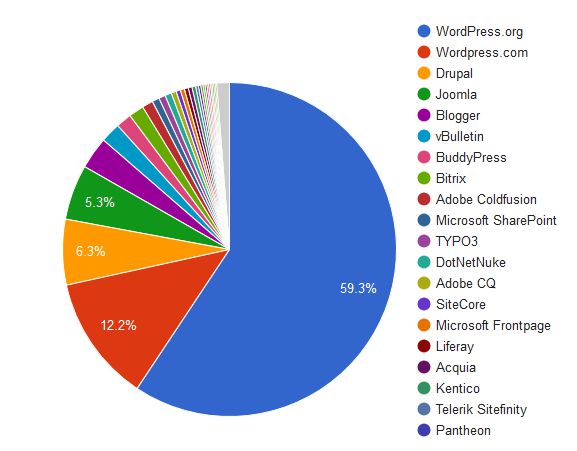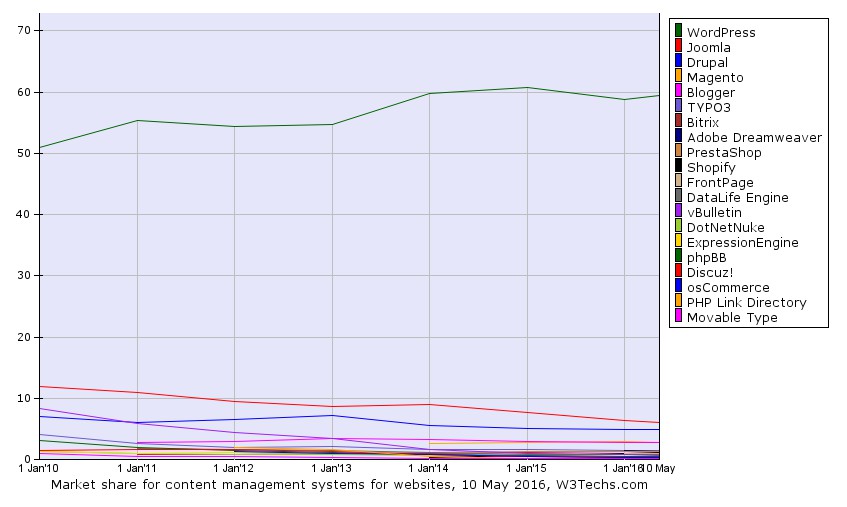If you run a website where you need to make regular changes to the content then a Content Management System (CMS) is the most cost-effective solution. And the ever growing WordPress market share shows that it is a dominant player in crowded open source CMS market
Why use a Content Management System?
We often bandy terms around so let’s not assume any prior knowledge. There are many good reasons for keeping a website updated but most important are keeping information accurate for users and search engines downgrade out of date websites and boost regularly refreshed websites in search engine results.
If your website is simple html, then anyone updating the content will need to know not only html code, but also CSS and possibly JavaScript or JQuery. While the task in hand might only be editing the words on a page, they need to know enough about all the other basic web page building blocks so they can fix something when it goes wrong or know to avoid tampering with important parts of the code. For example deleting a reference to the Style Sheet will result in a very different looking website.
Someone in your team may have these skills, but you will most likely need to pay a web developer to update your website. Some websites are simply online brochures so updating it every week isn’t necessary but if you do need to keep your website regularly updated then a CMS gives you greater control over your content and saves you money long term.
Using a CMS takes most of the stress and potential for disaster out of what should be a simple process of updating and editing a website. It allows someone to log in to an online Dashboard, call up a particular page, edit it using a WYSIWYG (What You See Is What You Get) editor, save the changes and they will automatically update the website without getting near the web page code.
WordPress market share compared to other CMS
We looked at two main sources for the data but both indicate that WordPress dominates the market.
Web data company Datanyze provide data based on the top 1 million websites according to Alexa. This shows that installed WordPress sites account for nearly of 60% of websites that use a CMS.

Source: https://www.datanyze.com/market-share/cms/
Another analysis from the Web Technology Survey company show that since 2010, WordPress has increased market share from 50 to 60%.

Source: http://w3techs.com/technologies/history_overview/content_management/ms/y
What’s so good about WordPress?
There’s nothing wrong with the main competitors such as Joomla or Drupal. They all use the same underlying technology PHP and MySQL. All have active developer communities that produce many good quality commercial or free plugins and extensions that help extend the basic functionality that help make websites work better for users.
What sets WordPress apart is the shallow learning curve needed for editing and updating website pages. It’s not intuitive, very little technology is, but the basic skill level needed to update a website isn’t much more than what is needed to update social media. There are additional skills and knowledge needed to really take a website on further but the basic knowledge to update a website is within the grasp of most.

Here are some typical types of website that you can create using the plugins available for WordPress:
- Gallery
- Blog
- Portfolio
- Rating Website
- Social network
- Online brochure
- Online shop
- Membership Site
- Resource booking
- Photographers’ website
- Events website
- Business Directory
In the unlikely event of a free or commercial plugin not being quite right for your purposes the open architecture of WordPress means that a competent WordPress developer will be able to customise or create from scratch a plugin that matches your requirements.
Further reading: Why You Should Use WordPress?
Free Blogging platform: WordPress.com
Download install version of WordPress: WordPress.org






